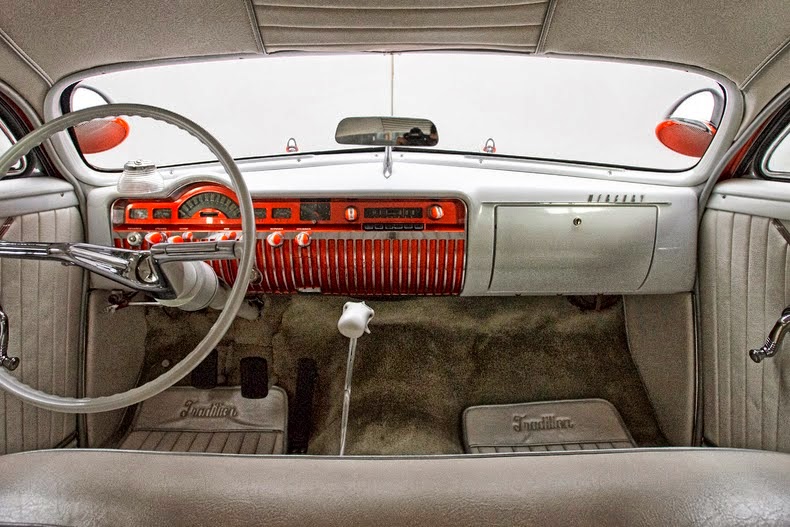The Mercury Eight was the first model of the Ford Motor Company's Mercury marque and was produced from the 1939 through the 1951 model years. It was the only model offered by Mercury until the marque starting producing multiple series in the 1952 model year, at which point it was dropped as a model designation.
1949–1951
Within its era and beyond, the Mercury Eight was popular with customizers. In 1949, Sam Barris built the first lead sled from a 1949 Mercury Eight; the Eight became the definitive lead sled, much as the Ford V-8 (as the "deuce") was becoming the definitive hot rod. The Eights were among the first models to receive an aftermarket OHV engine swap, since Oldsmobile and Cadillac developed the first high-compression OHV V8 engines in 1949, whereas Ford was still using a sidevalve engine. Sam and George Barris also used the 1949 body style to build "the most famous custom car ever", the Hirohata Merc, for customer Bob Hirohata in 1953. Setting a style and an attitude, it had a "momentous effect" on custom car builders, appeared in several magazines at the time, and reappeared numerous times since, earning an honorable mention on Rod & Custom's "Twenty Best of All Time" list in 1991. The Eight remains a very popular subject for car modellers.
Fiberglass replicas of the Eight, inspired by Sam Barris's car, are still in production and are popular with custom and rod enthusiasts.
In 1950, a high-end two-door Monterey coupe was introduced in the same vein as the Ford Crestliner, the Lincoln Lido coupe and the Lincoln Cosmopolitan Capri coupe in order to compete with the hardtop coupes General Motors had introduced the previous model year. The front suspension was independent with stabilizer bars. In 1952 the Monterey would become its own series.
In 1990, Mattel Hot Wheels created a model of 1949 Mercury with a chopped top. It is called Purple Passion. Purple Passion is one of most desirable and priciest Hot Wheels to ever be cast.
The car makes notable appearances in four films: Rebel Without a Cause (1955), American Graffiti (1973), Badlands (1973), and Cobra (film)(1986). ("Cobra" would use one of the first all-fiberglass copies.) A customized 1949 Mercury was also used to play the Batmobile in theBatman and Robin serial. The character Sheriff from Cars was a 1949 Mercury Police Cruiser.
The first postwar Mercury was introduced in the 1949 model year. The engine was a flathead V8 that produced slightly more power than the then also newly designed 1949 Ford. A new overdrive system was optional, activated by a handle under the dash. The styling of the Mercury Eight, when it was released in 1949, adopted the "ponton" appearance, and was successful in both ending the monotony of warmed-over pre-war style, and differentiating Mercury from its comparable Ford cousin, a trick that spelled sales success. Sales figures for both Ford and Mercury broke records in 1949. The new approach to styling was also evident on the completely redesigned Lincoln and the all new Lincoln Cosmopolitan. The Mercury Eight used full instrumentation. An 8 tube radio as an option. The 4-door station wagon was replaced with a 2-door model. Although the wagon now featured an all-metal roof, its sides still consisted of wood panels.
 |
| 1951 Mercury |
 |
| 1950_mercury_coupe |
 |
| Mercury Club Coupe_1951 |
Fiberglass replicas of the Eight, inspired by Sam Barris's car, are still in production and are popular with custom and rod enthusiasts.
In 1950, a high-end two-door Monterey coupe was introduced in the same vein as the Ford Crestliner, the Lincoln Lido coupe and the Lincoln Cosmopolitan Capri coupe in order to compete with the hardtop coupes General Motors had introduced the previous model year. The front suspension was independent with stabilizer bars. In 1952 the Monterey would become its own series.
In 1990, Mattel Hot Wheels created a model of 1949 Mercury with a chopped top. It is called Purple Passion. Purple Passion is one of most desirable and priciest Hot Wheels to ever be cast.
The car makes notable appearances in four films: Rebel Without a Cause (1955), American Graffiti (1973), Badlands (1973), and Cobra (film)(1986). ("Cobra" would use one of the first all-fiberglass copies.) A customized 1949 Mercury was also used to play the Batmobile in theBatman and Robin serial. The character Sheriff from Cars was a 1949 Mercury Police Cruiser.















